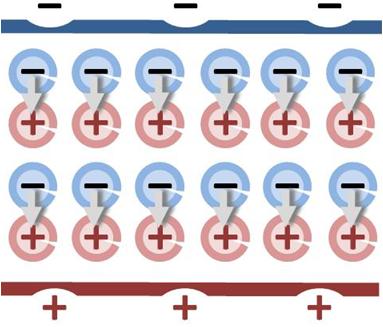property>electric dipole moment
What is the Electric Dipole Moment?

In physics, for any given system of charges, the electric dipole moment is a measure of the separation of positive and negative charges within that system. This effectively amounts to being a measure of the system’s polarity. To understand this, let’s begin with a very simple system of two point charges, one with a charge of +q, and another with a charge of -q, separated by some displacement, d. We would calculate the electric dipole moment, p, of the system in the following way:
p = q.d
In other words, the electric dipole moment is the same as the total charge q multiplied by the displacement vector, d. This is commonly known as the ideal point dipole. Notice that the magnitude of the electric dipole moment is completely dependent on the displacement such that the dipole gains more polarity as the two charges move further and further from one another. If the two charges aren’t separated at all, the electric dipole moment is reduced to zero. There can be no polarity if there is no separation of charges.
Let’s examine a much more general, real world, case. If there is a continuous charge distribution within a given volume V, one can express the electric dipole moment as:
p(r) = ∫v ρ (r0) (r0 - r) d3 r0
Starting from an initial point of observation r0, we integrate over the entire volume of charge density ρ(r). d3 r0 is taken to be an infinitesimal volume within the total volume V. So the integral is adding up infinitesimal charge densities with respect to an infinitesimal volume. The charge density function (r) is equal to:
ρ(r) = ∑ qi δ(r - ri)
The charge density at a given radius from the point of observation, r0, is equal to the sum of Dirac delta functions given by δ(r - ri) multiplied by the charge qi. Think of every ri as a vector that gets its direction from a reference point defined by qi. The charge density at a given point will depend on the separation of charge at that location. If we do some substitution, we find that:
p(r) = ∑ qi di
This is the same as saying the electric dipole moment is the same as the total amount of charges, either positive or negative, separated by some displacement d. If we were to give N a value of 2, we would end up with the case represented by the ideal point dipole where p = q.d.
Many substances are natural dipoles. One of them is water, which has a negative charge toward the oxygen atom and a positive charge toward the hydrogen atoms. There is a natural separation of charges in water due to the distance between the oxygen and hydrogen atoms. The fact that water is an electric dipole explains many of its seemingly bizarre properties, for example its high surface tension.